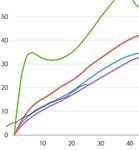wildebus
Full Member
- Messages
- 7,786
I think really a graph showing consumption/Hr rather than a consumption/mile is needed, especially if wanting to judge against a stationary engine, such as a generator.
That graph above could imply at first glance that an engine is using less fuel at higher speeds but that is not the case of course. (it does show that you get better efficiency driving at higher speeds (upto a point) though, which is interesting and might surprise Mr and Mrs Trilby)

